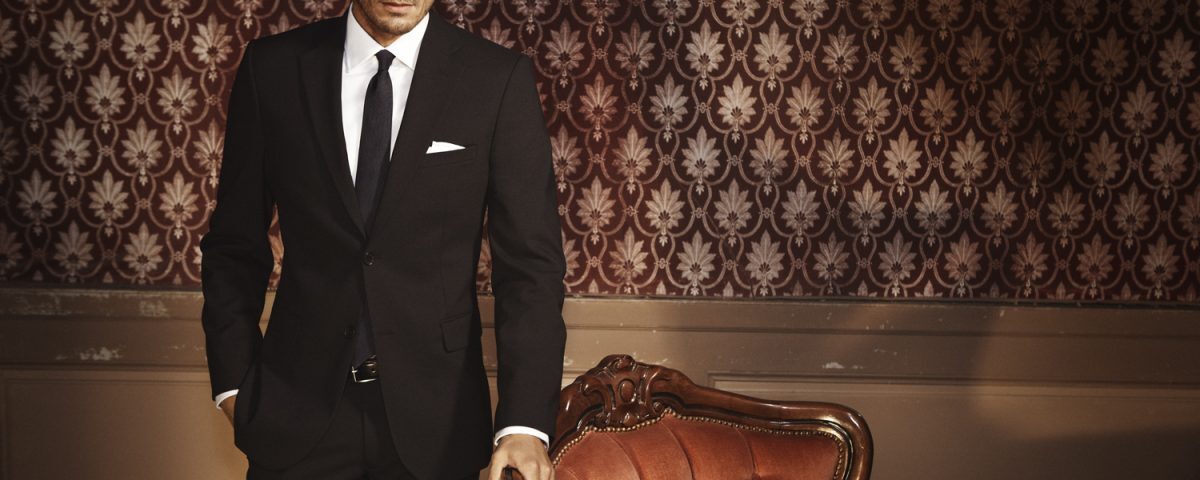
Sample from…
What To Look For In A Suit?
The suit isn’t just for serious grown up business men working in corporate offices (thought they seem to like them). Suits look great on any men — young or old — go with any existing look, and women love them too (which is a super bonus). The suit is the basic building block — whether you’re an office guy who needs to look sharp, or a creative type who dresses up because he wants to. A suit is a symbol of sophistication and offers men a chance to showcase their own personal style. Give three men each a black suit and the way they wear and accessorize will be different.
No, not every suit is the same. The first thing to consider before you spend hundreds or thousands of dollars on a well-made garment is what will you use this suit for? This might not be your very first suit, but something inspired you to go shopping for this (relatively) pricy item. Maybe it’s for work? An interview? A date? Or even a funeral? What you want to think about is purchasing a suit that you’ll get the most use out of as possible, so that means it has to be versatile. If you can think of several situations where you could wear it, then you’re making a smart purchasing decision. Just avoid choosing a suit that’s say, too formal or one that’s too stylistically left field that you’d rarely have another occasion to wear it.
Same for when you’re looking at color, patterns or fabric.
The Color of Money
Black for a first suit? It’s definitely the case that a simple classic suit in a dark color is not only the most practical but is also versatile — and will fit with many shirts, ties and other accessories to create a diverse range of looks. Some argue that there are other better first choice colors to consider before black, and that dressing in a black suit can most times make you look a little like a waiter, a funeral director or the people heading to court (who are not the lawyers). The better first choice could be navy or charcoal — colors which still fit with almost anything, give off a serious air, but are less obvious.
It’s up to you. Black can be dressed up with a bright tie and matching pocket square, or worn with a T-shirt for arty types — take either of these routes and you will avoid being asked for a menu.
If you wear suits regularly for work, then well… the world is your oyster. Have fun, be diverse and get a range of colors: lighter shades work well in summer (light grey, tan), and darker (black, navy, charcoal) in winter.
Pinstripe suits are a good business choice for anyone, assuming they’re on a conservative color like black, charcoal or navy, although they can be slightly less flexible in terms of what shirt/tie you can wear with them.
Bright colors? Well, the truth is some men can pull of wearing anything. It depends on your skin coloring, your overall style… and your occupation. A red suit might not go so well if you’re a criminal lawyer (unless you’re a criminal lawyer), but if you’re the creative director of a design company — then sure? Clients expect creativity.
Perfect Picks: Choosing Fabric
Deciding what type of fabric to choose can also seem daunting, but to be honest there are only a handful of suit fabrics worth your time.
Most good garments are made of wool. As wool’s a natural material, it breathes well, and is soft and wrinkle free. Common wool types include cashmere, merino, tweed, flannel, and worsted.
Linen is commonly used for summer suits since it’s lightweight and stylish — you’ll keep your coolness even in soaring temperatures. However it wrinkles and can stain extremely easily, so your cleaning/pressing bill can go up. Recommended if you live in the tropics!
Polyester can be a good option if you’re on a budget. Polyester wrinkles more than wool but less than linen, and because it’s a synthetic has a reputation for not breathing very well. Polyester produces more fabric shine compared to wool and cotton. You can however find polyester/wool blends which are a good middle-of-the-road choice. Polyester suits can be perfect to wear in spring and autumn.
Cotton is another popular fabric originally derived from plant fibers. Cotton suits move and breathe well and the fabric is practical and easy to take care of since it’s machine-washable. Cotton is a durable fabric that’s a excellent semi-formal suit for spring, summer and autumn.
Tailored or Ready-to-Wear?
For many perfectly sensible reasons, getting your suit tailor-made would be the #1 solution, but that’s not always practical for everyone and every budget. Also let’s be honest — there are a bunch of quality ready-to-wear suits hanging around on racks in retailers. Wander around. Prices are usually very reasonable and stores have a great range of the latest styles, fits and colors. On the flip side, many mass-produced suits fit the most common types, and yours might not be one of them.
However the tip to get around this is that most brands have their specific house cuts, which differ sizing wise. So in the first store you go to it’s entirely possible to find suits are too big or too small. The answer? Go elsewhere. You’re almost certain to find a brand which is fitting. It’s about taking the time to find a style that works best for your body type and you can always take your purchase to a tailor for small custom adjustments.
Sizing? This is how your Suit fits perfectly
SHOULDERS
The shoulders of a jacket are difficult-to-impossible to have adjusted, so it’s one part of a suit you need to make sure is correct. How to tell? The jacket seams on top of the shoulder should be the same length as your shoulder bone, and should meet the sleeve pretty much exactly where your arm meets your shoulder. Fold your arms around your chest and if it feels tight, it’s too small. Lean against a wall—if the jacket shoulder hits the wall before your arm, it’s too large.
CHEST
Your suit jacket should button easily without forcing you to breathe in and a slouchy, gaping look is a big no-no. Once it’s buttoned, place your fist between you and the jacket—you want some give but not too much, any wider and you’ll need a smaller size.
LENGTH
Your suit jacket needs to look like, well a jacket, not an overcoat or tank-top. Again the rule-of-thumb is pretty simple. Hang your arms down straight and cup the jacket hem in your hands. If you can’t reach it, then it’s too long. If it’s shorter, then it’s… well too short.
SLEEVE LENGTH
Sleeve lengths are easily altered, so if the rest of the jacket is fine but the sleeves are too long, that’s easily fixed. The ideal jacket sleeve length leaves about a quarter to a half-inch shirt sleeve showing. That means the jacket sleeve finishes just above the large bone in your wrist.
Pants. Yeah Get Some
The cut of trousers should fit the legs without being too tight or too baggy. Suits today favor a slim-fit appearance and modern suit pants will reflect this. Lengthwise it’s very common for trousers to be too long. We all vary in height and off-the-rack suits are all one size. Luckily having the pants hemmed up is the simplest operation from a professional tailor. The store will often take care of them for you. Invest in more extra trousers for a work suit you want to wear regularly. Buy at least two pairs of trousers to each jacket. This cuts down on dry cleaning, so will last you longer and will save you money in the long run.




